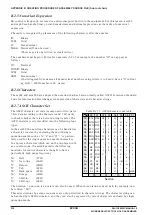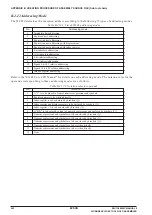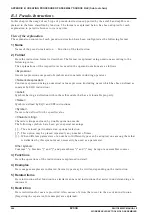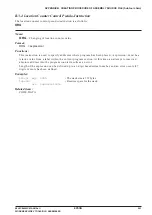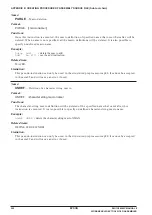
APPENDIX B CREATING PROCEDURE OF ASSEMBLY SOURCE FILE (Sub tool chain)
S5U1C88000C MANUAL II
EPSON
247
WORKBENCH/DEV TOOLS/OLD ASSEMBLER
B.3.2 Data Definition Pseudo-Instructions
Data definition pseudo-instruction is the pseudo-instruction to define data to be stored into the memory.
The data definition pseudo-instructions are as follows:
DB DW DL ASCII PARITY
Name:
DB
....
Reserve/constant setting of the byte unit data area
Format 1:
DB <expression> {,<expression>}*
Format 2:
DB <expression> (<numeric expression>) {,<expression> (<numeric expression>)}*
Format 3:
DB [<numeric expression>] {,[<numeric expression>]}*
Functions:
This instruction is used to reserve the 1 byte unit data area and to set the constant. The setting of
constants are done according to a string of numeric values delimited by a comma or the specification
for the repeat number. The parameters for this instruction can be described over several lines, but you
should take care that the relocation information for linking are not included. Further when this
instruction is used, it should be described within the DATA (RAM) area when reserving data area, and
within the CODE (ROM) area when setting constant. The code generation rules for each format are as
follows.
• Format 1
This format defines the optional constant as the optional number of object codes in 1 byte unit and
multiple expressions can be specified for an operand field. The expression is handled as constant
value of 1 byte and when multiple specifications are made, the object codes are generated in the order
of specification.
• Format 2
This format repeat defines the optional constant in 1 byte units and sets the repeat number in a
<numeric expression> enclosed by parentheses.
• Format 3
This format reserves the area for the number of bytes that have been assigned by the <numeric
expression> enclosed by brackets. The code generated within the object at this time is 0.
Integer numeric constants, character constants and symbols can be used as the expressions for formats
1 and 2, but they must necessarily have an absolute numeric attribute. The value of the expression
must also be within the range of -128 to 255. When an operation result is outside the above range, it
will be made an error and the value of the lower 1 byte will be made the evaluation value. Each
format can be premixed for one instruction.
Examples:
buffer:
db [50]
;
Reserves 50 bytes area
tratbl:
db '0','1','2','3','4','5','6','7','8','9','A','B','C','D','E','F'
;
Reserves 16 bytes data as the constant
xhrbuf:
db ' '(64)
;
Reserves 64 bytes and initializes at the character code for the space
db '*'(64)
;
Reserves 64 bytes '*' as the constant
Related items:
DW, DL






